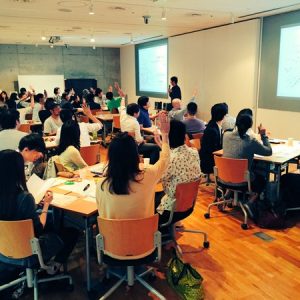
Leatning Infographics from Maps: Techniques of Data Visualization
Data visualization, transformation of pure text based data to visual presentation, is a very useful technique in communication. With a series of text blocks, readers, especially ones with limited experience on the domain mentioned by the data, will feel hesitate to proceed. It is usually a turn off for human mind to deal with a flood of details at once. Moreover, it is very easy to miss important points when reader tries to skim through those data. Those are the reasons why we should come up with different ways of presenting data. One of that methods is to visualize it in an effective way so that every can learn to read it fast and precisely without missing any points. We have introduced the effectiveness as well as the methodology of diagraming a conversation in the last workshop, which was “dialog – 2 – diagram”. It showed that visualization of a conversation helps to quickly grasp the gist of the story. And from different point of view on the conversation, it is possible to make different diagrams which unveil distinctive perspectives in a conversation. Can we apply these visualization techniques to scenarios other than a simple conversation? The answer is yes, we can. However, different types of scenarios bring different form of data. This variation in data type sometimes results in very complicated visualization. And it, same as a flood of text, becomes a turn off for our mind. One of the most infamous examples of this complication is railways maps, especially the one of Tokyo. There are so many lines with so many different directions. Some lines even share the same track with a slightly difference in time. And in order to encode these difference in a single 2D map, the designer have to come up with a bunch of rules about route coloring and dashing, position approximation, label annotation or legend placement. The designer has to be very careful in setting up the subtle difference between each route, otherwise, it will become a trap for reader to extract any useful information from the map. Besides addressing the making of Tokyo railway maps, our workshop will give a brief introduction about infographics and its applications. We will learn some very simple rules in data classification, color selection, timeline arrangement or perfectly sizing the charts. This will be a great chance for you to read the infographic, create an infographic for yourself and explore the artist side of your brain.
企画の背景
言葉や文章では説明や理解がしにくい事柄でも、図や絵によってなら容易に理解することができることが多くあります。特に情報化社会においてますます複雑になっている様々な課題にたいして、複雑な情報を視覚的に分かりやすい形にデザインして伝える技術である「インフォグラフィックス」は、デザインのみならずプレゼンや資料作成などあらゆる場面で重要な要素となってきています。多数の階層に散らばった大量の情報を一枚の図に分かりやすくまとめている最たる例が地図です。その地図を題材とすることで情報を可視化する技術についても理解を深めるられることが期待されます。
どんなワークショップ?
4~5人のグループに分かれ、壇上での講師の説明や講義を聞いた後に、グループの個々人が共有アイテムを使用してそれぞれ自分の作業を行い、その後グループ内でディスカッションを行い、最後に再び講師が壇上でまとめの言葉と、特徴のある作品の紹介を行う、という流れをそれぞれの作業単位で行いました。
壇上での講義は充実の内容で、地図ならではの制約であったり、カッコいいけど理解しにくい地図がどのようなものなのか、などについてお話してくださいました。第一の課題は、「電気製品の普及率と住環境の変化」について、リストアップされた電化製品をグループに分類する作業を行いました。第二の課題では、今までの自分の人生を、複数の色の濃淡で整理して図化することを行いました。最後は、数値化できないストーリーを一つの図にして描くことを行いました。
プログラム
| 13:00 - 13:30 | 導入・自己紹介 | |
|---|---|---|
| 13:30 - 16:30 | 講義・ワークショップ | |
| 16:30 - 17:00 | 質疑応答・ディスカッション |
ワークショップの成果
複数の階層に分かれて絡み合った情報を分かりやすく一枚の図にまとめるスキルを、実作業を通して向上させることができました。特に「分かりづらくならない制約の中で最大の情報量を詰め込む」ことは自分たち工学系にとっても仕様書やポンチ絵などでやりたいことであり、ぜひ身に着けたい技法であったため大いに勉強になりました。
ふり返り
今回のワークショップでは、地理人さんのトークが軽快でテンポよく、内容的にも興味深いものであったため、大変楽しめる内容でした。このワークショップで身に着けることのできるスキルは大変実用的でその分ある程度世の中で確立されている技法なのではないかと感じました。それならば、自由に作業させてもらう前に、「このようなことを表現するならこういう例やこういう技法がある」といった、いわば定石的な例を講義形式でまずは説明していただき、その後後半でそういった手法を活用して自由な発想のもとに作品を制作する、という流れとすることで紹介してもらった技法を自分のものにすることができ、また道に迷って手持ち無沙汰になることを避けることができるのではないかと思いました。
| アイテム | 模造紙、付せん紙、はさみ、のり、マーカーペン |
|
|---|---|---|
| 開催日時 | 2016.10.8(土) 13:00 - 17:00 |
|
| 場所 | 東京大学大学院情報学環・福武ホール |
|
| 参加者・人数 | ★名 |
|
| 講師/ファシリテーター | ゲスト/ファシリテーター |
原稿執筆:安斎勇樹


